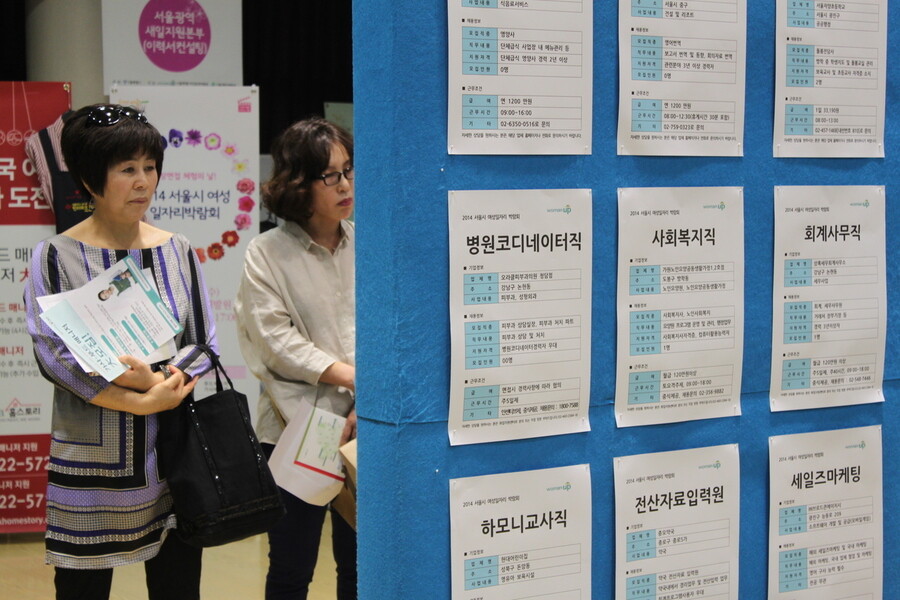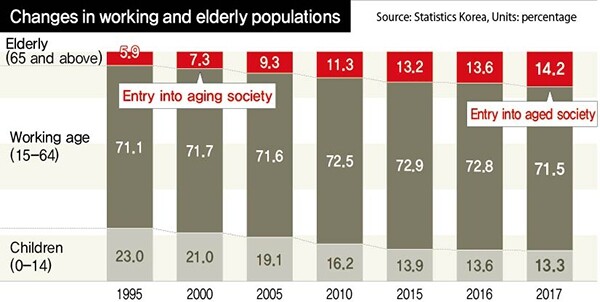hankyoreh
Links to other country sites 다른 나라 사이트 링크
South Korea officially an aged society just 17 years after becoming aging society

As South Korean society ages and the birth rate decreases, the country officially became an aged society last year, meaning that the elderly account for more than 14 percent of the total population, the latest census has found. Furthermore, the working age population (representing those between the ages of 15 and 64) declined for the first time last year. For dozens of years, the population factor has been driving growth in the South Korean economy, but now it has become the greatest risk for that economy’s future.
The results of the “2017 Population and Housing Census,” which Statistics Korea announced on Aug. 27, show that the elderly population in the country (defined as South Korean nationals aged 65 and above) had reached 7.12 million by Nov. 1, representing a 340,000 increase from 2016. The elderly proportion of the total population also increased from 13.6 to 14.2 percent, finalizing the country’s entrance into the ranks of aged societies. South Korea’s total population last year (including foreigners) was 51.42 million, representing a 0.3 percent increase from the year before (51.27 million).

South Korea estimated to become super-aged society by 2026
International organizations such as the UN categorize an “aging society” as one in which the elderly represent at least 7 percent of the population, an “aged society” as one in which they represent at least 14 percent and a “super-aged society” as one in which they represent 20 percent or more. South Korea has become an aged society after 17 years as an aging society, which it became in 2000 when the elderly proportion of the population reached 7.3 percent. Statistics Korea explained that this was the fastest transition in the world.
“In the case of Japan, it took 24 years for the elderly population to increase from 7 percent in 1970 to 14 percent in 1994. Our population is aging much more rapidly than other countries,” said Yang Dong-hui, head of the census section at Statistics Korea.
South Korea is estimated to become a super-aged society in 2026. Whereas it’s expected to take about a century for countries such as the US and the UK to transition from an aging society to a super-aged society, this timeframe has basically been shrunk to 26 years in South Korea.
But the decreasing birth rate dragged down the young population (those below 15 years of age) by 140,000 over the past year, from 6.77 million in 2016 to 6.63 million in 2017, as their share of the total population shrank from 13.6 to 13.3 percent. This caused the aging index, defined as the number of elders per 100 young people to rise to 107.3, a year-on-year jump of 7.2 people. Since the total fertility rate dropped to 1.05 last year and is expected to fall below 1 this year, there’s unlikely to be a rebound in the young population in the short term.
Decline in working population
Another notable phenomenon is the decline in the working-age population, the people responsible for supporting the young and the elderly. Last year, the working-age population fell to 36.2 million, down 110,000 from 2016 (36.31 million). This population had continued to rise through 2016, posting a 7,000 year-on-year increase, until shifting to a downward trend last year.
This was quite a drop-off, considering that Statistics Korea had forecast that the working-age population would decline by 7,000 in 2017 in its “Long-Term Population Projections” published at the end of 2016. The decline in this population is currently regarded as one of the major causes of the recent slowdown in the number of employed individuals. This means that the aging population is beginning to have a tangible impact on the economy.
Last year, the International Monetary Fund (IMF) identified “aging” as the biggest economic risk facing the countries of Asia and lumped South Korea in the group of countries in which the ratio of the elderly to the working-age population is drastically increasing while the working-age population is declining in absolute terms.
These variations in the population structure are also bringing major changes to household composition. Last year, there were a total of 20.17 million households in South Korea, up 330,000 (1.7 percent) from 2016 (19.84 million). The number of households grew at a rate faster than the actual population as one- and two-person households increased at the expense of the traditional family structure, composed of a married couple and children. Last year, there were 5.62 million one-person households, accounting for 28.6 percent of all households.
The aging of society was also found to have an impact on household characteristics. The average age of all householders rose to 51.7 years, up 0.4 years from the year before, while people aged 70 years and above accounted for 18 percent of one-person households, more than any other age group.
By Bang Jun-ho, staff reporter
Please direct comments or questions to [english@hani.co.kr]

Editorial・opinion
![[Column] Has Korea, too, crossed the Rubicon on China? [Column] Has Korea, too, crossed the Rubicon on China?](https://flexible.img.hani.co.kr/flexible/normal/500/300/imgdb/original/2024/0419/9317135153409185.jpg) [Column] Has Korea, too, crossed the Rubicon on China?
[Column] Has Korea, too, crossed the Rubicon on China?![[Correspondent’s column] In Japan’s alliance with US, echoes of its past alliances with UK [Correspondent’s column] In Japan’s alliance with US, echoes of its past alliances with UK](https://flexible.img.hani.co.kr/flexible/normal/500/300/imgdb/original/2024/0419/2317135166563519.jpg) [Correspondent’s column] In Japan’s alliance with US, echoes of its past alliances with UK
[Correspondent’s column] In Japan’s alliance with US, echoes of its past alliances with UK- [Editorial] Does Yoon think the Korean public is wrong?
- [Editorial] As it bolsters its alliance with US, Japan must be accountable for past
- [Guest essay] Amending the Constitution is Yoon’s key to leaving office in public’s good graces
- [Editorial] 10 years on, lessons of Sewol tragedy must never be forgotten
- [Column] A death blow to Korea’s prosecutor politics
- [Correspondent’s column] The US and the end of Japanese pacifism
- [Guest essay] How Korea turned its trainee doctors into monsters
- [Guest essay] As someone who helped forge Seoul-Moscow ties, their status today troubles me
Most viewed articles
- 1[Column] The clock is ticking for Korea’s first lady
- 2After 2 months of delayed, denied medical care, Koreans worry worst may be yet to come
- 3Hong Se-hwa, voice for tolerance whose memoir of exile touched a chord, dies at 76
- 4[Column] Has Korea, too, crossed the Rubicon on China?
- 5US overtakes China as Korea’s top export market, prompting trade sanction jitters
- 6Samsung barricades office as unionized workers strike for better conditions
- 7[Editorial] As it bolsters its alliance with US, Japan must be accountable for past
- 8[Correspondent’s column] In Japan’s alliance with US, echoes of its past alliances with UK
- 9All eyes on Xiaomi after it pulls off EV that Apple couldn’t
- 10[Correspondent’s column] The US and the end of Japanese pacifism